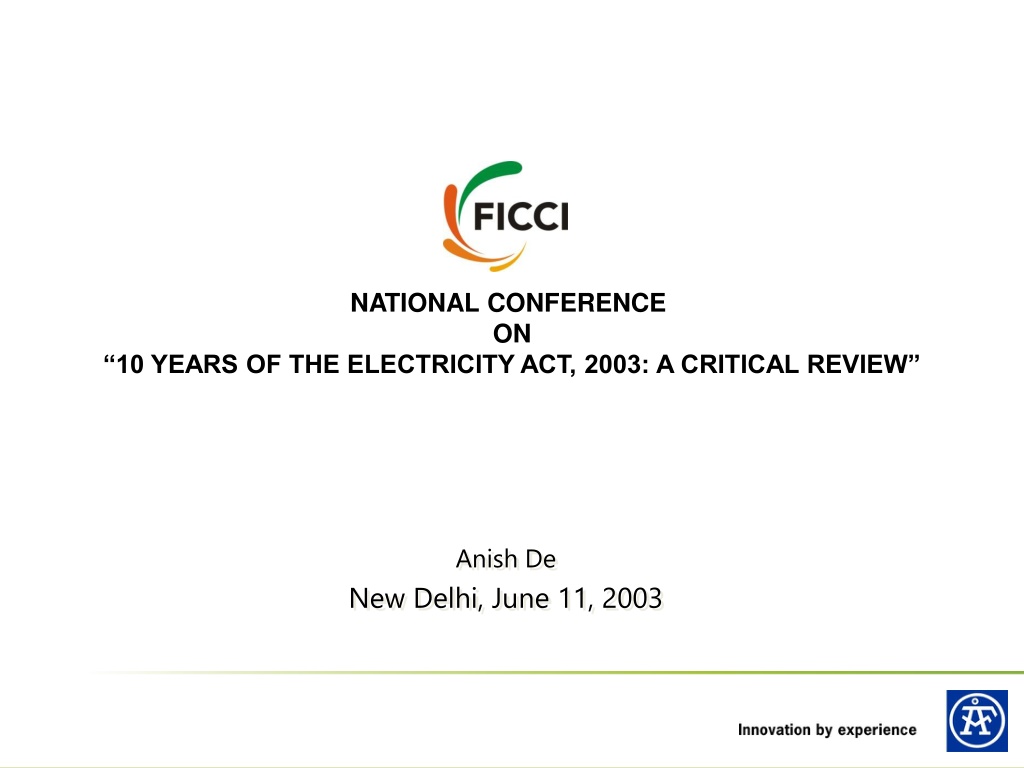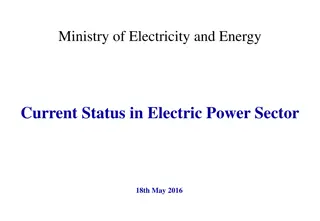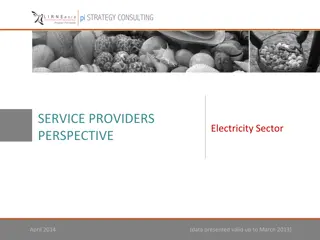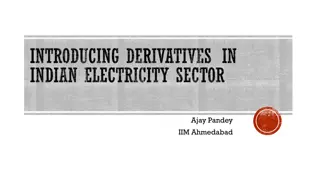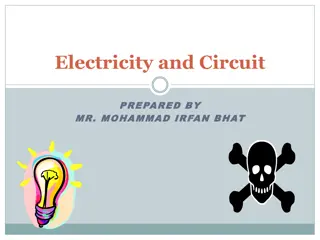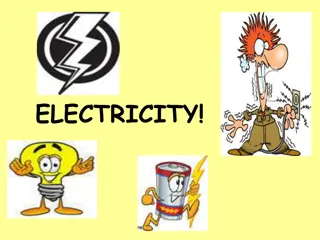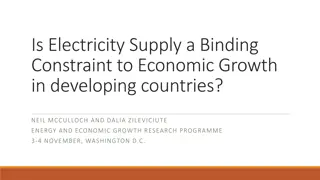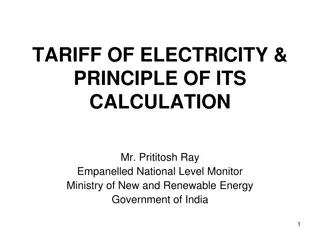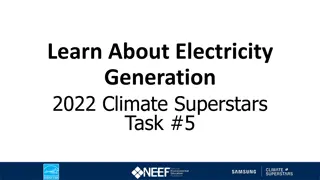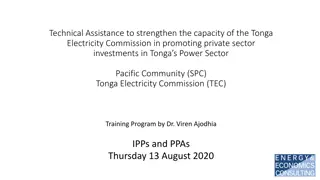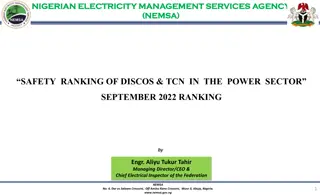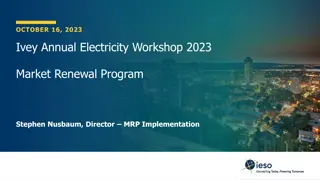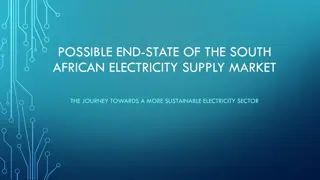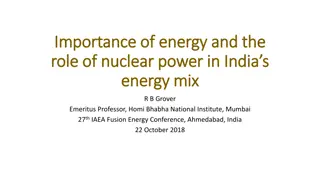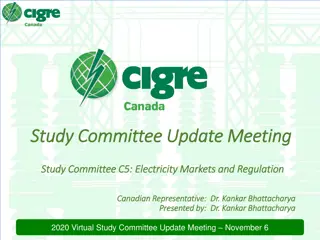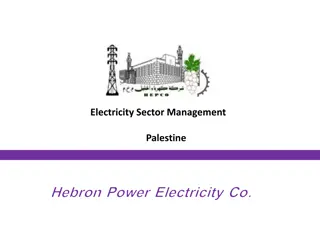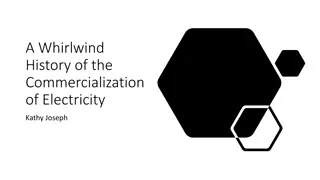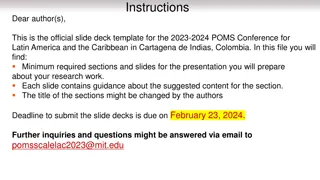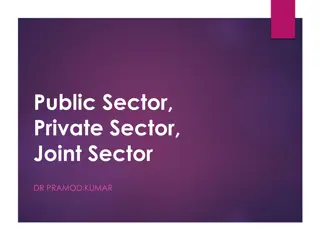Evolution of India's Electricity Sector: A Decade Review
The National Conference on the 10 Years of the Electricity Act, 2003 provides a critical assessment of the key changes ushered in by the law, emphasizing the importance of investments in infrastructure, defined energy exchange rules, transparent regulation, and institutional capabilities. The evolution includes capacity additions driven by policy reforms encouraging private sector participation, improvements in the transmission system towards a national grid, and the need for addressing challenges like fuel shortages and project implementation delays.
- Electricity sector
- Policy reforms
- Private sector participation
- Infrastructure investments
- Transmission system
Download Presentation

Please find below an Image/Link to download the presentation.
The content on the website is provided AS IS for your information and personal use only. It may not be sold, licensed, or shared on other websites without obtaining consent from the author. Download presentation by click this link. If you encounter any issues during the download, it is possible that the publisher has removed the file from their server.
E N D
Presentation Transcript
NATIONAL CONFERENCE ON 10 YEARS OF THE ELECTRICITY ACT, 2003: A CRITICAL REVIEW Anish De New Delhi, June 11, 2003
Summary of fundamental changes brought about by the new law Freedom to procure Freedom to sell Economics in preference of command and control structure 3 Slide from Electricity Act, 2003: An analysis of Open Access and Trading issues, Anish De, June 11, 2003
Conclusion Freedom to buy and sell is not adequate. We need .. 1. 2. 3. 4. 5. 6. Investments in network infrastructure Defined rules of energy exchange Accounting and settlement systems A system whole for cash Transparent and equitable regulation Institutional capability in operators and regulators 4 Slide from Electricity Act, 2003: An analysis of Open Access and Trading issues, Anish De, June 11, 2003
Capacity addition driven by policy reforms encouraging private sector Capacity added in last 5 years of which 42 GW under bidding in excess of 75 GW the competitive Increase private sector from 17 GW in 2007 to 62 GW in 2012-13 in market share of Capacity gaining momentum, with 14 GW added in last five years. addition through RE Source: CEA Despite positive developments, challenges still remain Domestic Fuel shortage & expensive imported coal resulting in stranded capacity Poor management of peak load requirement still remain a cause for concern Slow implementation of projects, delay in environment clearances or land acquisition 6
Transmission System evolved from regional boundaries to national grid Improved operations backed by institutional frameworks standardized grid operations and Adoption levels construction of HVAC & HVDC systems of higher to voltage up 1200 kV, SR is expected to be integrated with the NEW Grid, forming the National Grid, with more than 230 GW of installed capacity Private encouraged model sector participation and IPTC JVC Source: AF- Mercados EMI Analysis However, failure of defence mechanisms such as load shedding schemes through under frequency relays, rate of change of frequency relays & islanding schemes in the NR and ER were observed (July 2012) 7
Volumes Lost due to Congestion Historical Trend Uncleared Volumes on IEX 800 45% 40% 700 35% 600 30% 500 Percentage 25% MUs 400 20% 300 15% 200 10% 100 5% - 0% Jun Aug Oct Dec Feb Apr Jun Aug Oct Dec Feb Apr Jun Aug Oct Dec Feb Apr Jun Aug Oct Dec Feb Apr Jun Aug Oct Dec Feb 2008 2009 2010 2011 2012 2013 Volumes Lost due to Congestion Volumes lost as a percentage of Constrained Volumes - Volumes cleared after price matching are presently being lost on the exchange due to congestion in the transmission network - In the last 6 months (Oct, 2012 March, 2013), the average un-cleared volume was 2.7 BUs which is 21.5% of the total volumes cleared on the exchange . 8
A Vibrant New Competitive World 9
Power Trading & Markets: Unlocking of the unused/economic capacities in the sector Electricity Transacted on OTC and Power Exchange in Total Electricity Generation Power trading accounts ~9% of the total net generation 10.00% 8.28% 7.88% 8.00% 6.73% 6.00% 5.25% Optimum network through strengthening investments utilization & efficiency increased of the 3.57% 4.00% 3.15% gains system 2.49% 2.41% 2.16% 2.00% 0.00% 2004-05 2006-07 2008-09 2010-11 2012-13* Sale of surplus captive capacity to deficit third party Price of Short-term transactions of Electricity during 2009-13 Power Market accounts to 97% of the total volumes traded via Day Ahead Source: CERC Monthly Market Monitoring Reports * Data for 2012-13 available for 11 months, has been pro-rated for 12 months However, challenges do exist Growth of the market is deterred by poor transmission system and congestion Improved transmission system needs to be adopted to reduce the loss of power 10
Industrial Consumers Major States Most of the consumers are located in Tamil Nadu, Punjab, Rajasthan, Haryana, and Madhya Pradesh. During the year 2012-13, Andhra Pradesh experience its worst ever power crisis due to shortage in gas and poor rainfall. The Industrial Consumers had to choose between either 3 continuous days power cut in a week or 12 continuous days power cut in a month. It is only post this that the Discom has granted Open Access to its Industrial Consumers. The consumption of the State has increased significantly over the earlier years. State-wise Number of Industrial Consumer at IEX in March 2012 600 482 500 400 317 300 200 103 48 45 44 100 43 30 16 12 8 4 4 3 1 1 1 1 0 No. of Open Access Consumer in March 2012 Source: IEX website 11
Distribution Sector: Slow Improvements Trend in T&D losses Policy strengthen the distribution sector reforms undertaken to Pre Electricity Act Post Electricity Act 40% 32.54% 32.86% 35% 31.25% 28.65% 33.98% 25.47% 30% 23.97% 32.53% Percentage 30.93% 30.42% 25% 27.20% 25.39% 20% Privatization Franchisee R-APDRP Viability Gap Funding, now being tested Financial Restructuring Plan 22.39% 15% 10% 5% 0% Source: CEA Average Gap (Rs./kWh) 6.00 4.87 4.84 4.76 4.6 5.00 4.04 R-APDRP has had reasonable impact in reducing T&D losses, however the progress has been slow 3.80 3.57 3.26 Rs./kWh 4.00 3.33 3.06 3.00 1.43 1.34 2.00 1.27 1.07 0.98 1.00 0.00 2007-08 2008-09 2009-10 2010-11 (RE) 2011-12 (AP) Directed by the APTEL, over the past 24 months, regularly revised the tariffs SERCs have Unit Cost Average Tariff per Unit Gap (per unit) Source: Planning Commission Annual Report 2011-12 Despite reforms the challenges remain T&D losses remain unacceptably high The tariff revisions has not been adequate to recover increasing costs. Unsustainable level of borrowings of utilities pose a serious threat to the banking sector 13
Unbundling of the utilities: Not able to achieve the set targets Process incorporated separate companies for G, T, D of unbundling to was ensure Has led to: Improved Transparency and Process of unbundling began in 1995, with Orissa SEB Accountability unbundling of Increased private sector participation Unbundling has been adopted by almost all state utilities*; although power are yet to operations Significant efficiency departments unbundle improvement in generation their and transmission *JSEB and KSEB are the only two utilities to remain bundled. Key Challenges being faced: Lack of coordination among unbundled utilities Inefficiency still pertinent in the utility operations Bureaucracy still persistent in the un-bundled set up Utilities unable to in-corporate the corporatized structure as per the Companies Act, 1956 14
Obligation to supply & flawed framework for rural electrification Progress of electrification under RGGVY National Electricity Policy specified the goals with respect to access & supply 60% 55% % of RHH electrified Several policies & programs introduced to improve access and service quality 50% 45% 40% RGGVY develop rural electrification India s flagship policy to 35% 30% 2005 2006 2007 2008 2009 2010 2011 Aim was to provide electricity to 23.4 million BPL households by 2009 (@ Rs 16, 000 cr) % of RHH electrified Source: Rajiv Gandhi Rural Electrification Program Urgent Need for Mid-course Correction. Prayas Energy Group, June 11 Challenges faced by obligation to supply & RGGVY: Obligation to supply interpreted as obligation to connect only, while ignoring quality of supply RGGVY as a program has faced numerous criticism: o Exceeding initial cost estimate by 225% o Failure of franchisee models at rural level o Lack of robust infrastructure, puts the whole system at risk o New connection primarily to the subsidized BPL customers 15
Financial Health of Unbundled Utilities - Discoms Unbundled Utilities - Six Year Averages (2005-11) - Ranked on basis of Net Profit Margin Net Profit Margin Net Profit Margin (w/o subsidy) (ACS-ARR w/o subsidy)/ACS Debtor Days Creditor Days Interest Coverage Ratio Energy Handled on average - BU Subsidy Aggregate, 2005-2011 (in Rs. Mn.) A -ve value means profits States Delhi West Bengal Andhra Pradesh Gujarat Rajasthan Karnataka Maharashtra Assam Orissa Haryana Chhattisgarh 15 0 3.06% 3.06% -3.43% 89 6 2.15 17 0 0.93% 0.93% -1.10% 79 38 1.21 51 269030 0.48% -27.90% 20.9% 77 53 1.13 36 67870 0.30% -8% 7% 53 0 1.18 25 376430 0% -66% 36.90% 110 56 1 30 91400 -2.20% -17.60% 15% 166 125 0.6 56 4283 -2.73% -2.98% 2.72% 146 49 0.13 2 2520 -3.20% -3.20% 6% 116 126 -1.67 10 0 -4.60% -4.60% 4.34% 148 180 -0.24 19 140837 -8.91% -47.00% 32.00% 152 68 -1.26 11 0 -9.50% -9.50% 8.64% 101 0 -4.36 Uttarakhand 5 0 -18.50% -18.50% 15.30% 229 340 -2.44 MP 20 46860 -20.30% -32.00% 24.00% 201 118 -4.79 UP 36 93500 -34.00% -53.00% 34% 310 413 -5.17 Source: PFC, AF Mercados EMI Analysis - Even though Gujarat and Maharashtra discoms are in losses, the level of Revenue Gap is still at a very manageable level. Also, Gujarat s operating earnings are enough to cover its interest expenses. - UP and Rajasthan are the worst performers. In both the states discoms, the costs are greater than 150% of the revenues. - In both AP and Haryana, a huge amount of subsidies is being provided to cover as much of the Revenue Gap as possible. Worst Performer Bad Performer Best Performer Second Best Performer ACS Average Cost of Supply ARR Average Revenue Realized 16
Financial Health of Bundled Utilities Bundled Utilities - Six Year Averages (2005-11) - Ranked on basis of Net Profit Margin (ACS-ARR w/o subsidy)/ ACS Net Profit Margin (w/o subsidy) Subsidy Aggregate, 2005-2010 (in Rs. Mn.) Net Profit Margin Debt- Equity Ratio Interest Coverage Ratio Output Units - BU Debtor Days Creditor Days States A -ve value means profits -3.87% Kerala 12 269130 3.72% 2.95% 83 86 1.39 1.67 Himachal 5 1214 -0.75% -2.09% 2% 46 123 10.1 0.87 Meghalaya 0.8 1047 -6.65% -12.14% 13% 295 171 6.21 0.49 Tripura 0.5 1690 -7.33% -19.50% 14% 27 0 0 n.a Punjab 29 147060 -9.90% -41.00% 29% 75 14 3.96 0 Tamil Nadu 49 74701 -26.45% -38.80% 26% 86 40 13.69 -1.49 Jharkhand 4 15708 -35% -52.00% 34% 305 259 n.a -0.64 Bihar Source: PFC, AF Mercados EMI Analysis 4 49240 -36% -97% 49% 784 94 n.a -0.05 - Out of the bundled utilities, Kerala is one of the rare states with a positive profit margin. Most of the bundled utilities are suffering heavy losses. - Bihar and Jharkhand have performed very poorly in the last five years. In fact, Bihar has losses that are almost equal to its revenue. Also, the BSEB s debtor days are more than 2 years. - In spite of reporting low T&D loss figures, Tamil Nadu has huge negative margin and a significant financial Gap. Worst Performer Bad Performer Best Performer Second Best Performer 17
Privatization and PPP- A tepid attempts Comparison of efficiency pre and post privatization: Delhi- 2008-09 Orissa was the first state to implement privatization of its discoms 60% 9% 8% 50% 7% 6% 40% 5% 4% 30% 3% 20% 2% 1% Have faced several issues in eliminating the inefficiencies 10% 0% NDPL BRPL BYPL 0% NDPL BRPL BYPL Baseline transformer Failure rate Baseline AT&C loss Current AT&C loss Current transformer failure rate 60% 140% Delhi was the second state to privatize its discoms 120% 50% 100% 40% 80% 30% 60% 20% 40% Delhi s discoms were able to improve the efficiency on the base line data However, deficits in regulation persist 10% 20% 0% 0% NDPL BRPL BYPL NDPL BRPL BYPL Baseline T&D loss Current T&D loss Baseline collection efficiency Current collection efficiency Challenges faced by Privatization model: Orissa s privatization failed due to lack state Govt. s commitment and lack of proper baseline data collection Delhi s model faced issues related to deficits in regulations 18
Privatization and PPP- A tepid attempts (contd...) Second set of privatization implemented was the franchisee model Key Improvement in Bhiwandi Circle model At the time of takeover 2010- 11 Parameter First established in 2007, in Bhiwandi has been able to significantly Distribution Transformer Failure Rate Load Shedding (Hours) Accurate Metering improve efficiencies 40% 2.80% However, model adoption by other states has been slow 10-12 <3 23% 99% 18.80 % 99% The licensees to operate in a given area, with a rational to eradicate the monopoly of the licensees Act allowed multiple distribution AT&C losses 58% Collection Efficiency 58% Source: Torrent Power Presentation Has faced several issues, however the provision itself is consumer the decision maker unique and makes Challenges faced by Franchisee and Multiple Licensee model: Franchisee model has been tried in other parts of the country, but the Bhiwandi s results haven t been replicated Multiple licensees is not feasible on a large scale without serious loss of efficiency. Multiple licensee face issues related to tariff determination and consumer loss. 19
Indias Experience With Regulation in the Past Decade is Very Mixed.... Aspect Act section CERC Role and status SERC Role and status Well set regulations following Multi-year tariff (MYT) structure as prescribed in the Act Relatively weak regulations (typically annual tariff review although MYT prevalent) Regulate generating and licensees the tariff companies of structures, now 79, 86 is more Introduce open phases distribution in Regulators in several states have actively blocked many states access such 42 Not relevant open access in In most states the utilities actual cost has been poorly estimated due to weak regulatory processes. pass through inadequately established Regulate procurement distribution licensees electricity by 86 Not relevant Cost mechanisms Determine charges, surcharge and additional charges wheeling Regulators in several states have actively blocked many states through exorbitantly high charges cross-subsidy open access use in of 42, 79, 86 Not relevant Facilitate and electricity transmission wheeling Has structured open access regulations that facilitate transactions of 79,86 As above * AF Mercados EMI analysis/views. 21 Roles have been carried out well Partial Achievement Poor Performance
Indias Experience With Regulation in the Past Decade is Very Mixed.... Act Aspect CERC Role and status SERC Role and status section IEGC developed an revised regularly depending on emergent conditions Weak state grid codes major hindrance to open access and renewables Specify Grid Code 79,86 Specify and standards with respect quality of supply enforce the to Even where established the standards are rarely enforced 86 Has actively managed the market to prevent abuse Has actively promoted markets through trading and Px. Has also promoted renewable energy markets Formulated regulations that are presently under finalisation Fix the trading margin 79,86 Not a major role Develop power markets 66 Not a major role Prevent market domination 60 Not a major role Promote generation of electricity from renewable sources. Renewable Obligation co-generation and Poorly executed. In most states with resource limitations the RPO standards are below desired levels and/or enforcement is poor. Fix 86 Not relevant Purchase * AF Mercados EMI analysis/views. Roles have been carried out well Partial Achievement Poor Performance 22
What is In Store for the Consumer? 23
Will The Indian Customer Ever Have Reliable Electricity? Peak Deficit -2012-13 50,000 -25.00 45,000 Even addition, peak deficits persist -20.39 40,000 -20.00 with large capacity 35,000 Deficit - % 30,000 -15.00 MW 25,000 -11.37 -9.66 20,000 -10.00 Given the baseload dominance in the capacity mix , meeting peak demand (and maintaining spinning reserves) would be a very expensive exercise where large and expensive generators would operate at part capacity 15,000 -7.45 10,000 -5.00 5,000 -1.47 0 0.00 Northern Western Southern Eastern North Eastern Peak Demand (MW) Peak Met (MW) Deficit % Source: CEA Power Supply Position Marginal generation costs (Rs./kwh) Increase in prices The through altering the capacity mix and/or markets mix can be corrected Increase in quantity supplied Source: AF Mercados EMI Analysis 24
Competition in Wholesale & Retail Markets Retail Choice & Competition Open Access The buyer can procure power from either generator, discom or the trader Provision enables consumer to chose an alternate supplier Mandated to counter the monopolistic practices of distribution licensee Grants choice and access for the consumer Aims to improve efficiency of operation by introducing competition Retail tremendous cost efficiency, cost and service related gains supply can provide Operated market level at whole sale and retail Challenges faced in Open Access and Retail Choice & Competition Resistance from licensee; in fear of loss of industrial consumers Unpredictability of charges based on region, e.g. West Bengal, Tamil Nadu and Punjab have high cross subsidy surcharge. Regulatory Gaps, no mechanism to calculate stand-by & additional charges Inadequate transmission facility , esp. in the SR is a bottleneck Retail Supply of electricity is still under distribution licensee 25
Action Plan for Short, Medium and Long Term Rationalization of subsidies and alternate model for subsidy payment should be considered Strengthening of Governance Regulatory Independence: Proactive role in implementing change in provisions relating to Open Access, MYT and SOPs Assessment of regulatory performance and ensuring accountability Loss strengthened DSM and energy efficiency at customer end to be encouraged Reduction and Efficiency improvement measures to be Utility Reforms Tariff Revisions to be regular and should not mask inefficiencies Open Access: Measures to rationalize charges and cross subsidy, augmentation of infrastructure, creation of awareness Market Reforms Preventing misuse of legal safeguards such as Sec 11 Competition in Retail Supply will require legislative changes Creating deeper competitive markets 26
Action Plan for Short, Medium and Long Term (contd ) Customer Service Orientation Efficient Power Procurement Practices and inventory planning Strengthening System & Processes IT & C contributing to better network data generation, management and control systems Monitoring & Evaluation: Regular audits by third party agencies and reviews Expanse and complexity of the sector requires deep skills on a large scale, perhaps like no other sector Building Human Capital Development large scale consumer awareness is also a requisite for holistic sector development The Electricity Act, 2003 has created a very strong and enabling framework for sector development Regulations have performed admirably at central level, however the deficit at state level are stark Measures needed that make regulators more independent, competent and accountable 27
